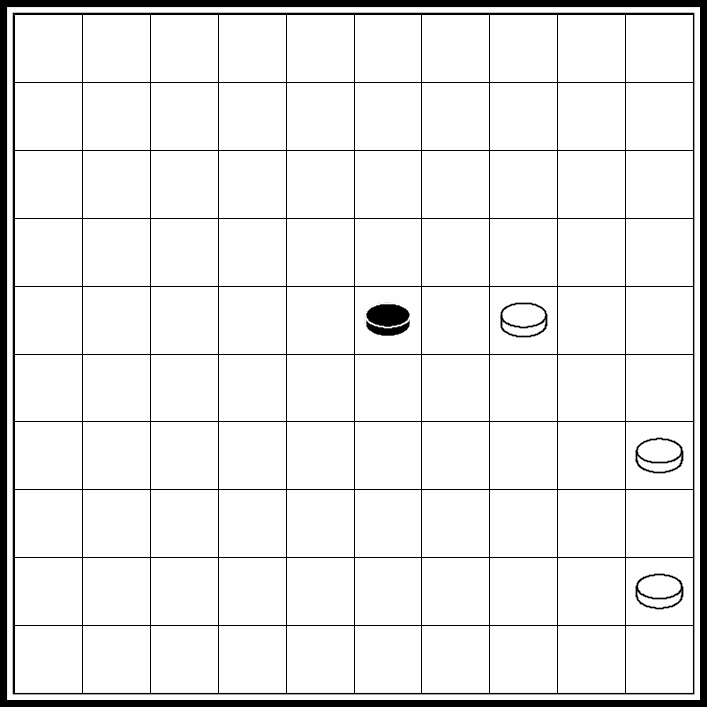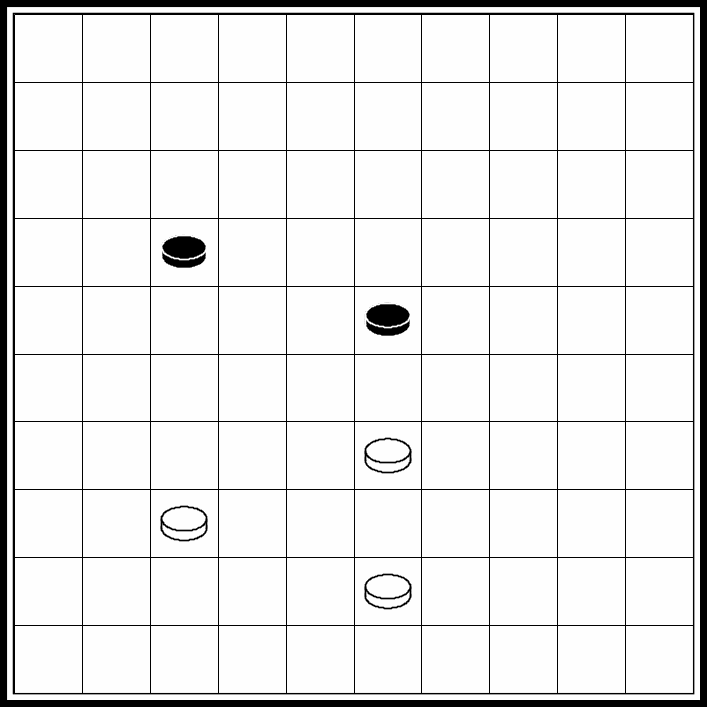
- •A course in international draughts
- •Sources
- •Introduction
- •About the author
- •Thank you!
- •Notation
- •2. Combinations
- •3. Coup Philippe
- •4. Harlem shot
- •5. Coup Royal
- •The Olympic formation.
- •6. Kung Fu shot
- •7. Ping Pong shot
- •8. Bomb shot
- •9. Arch shot
- •Grand prix shot
- •10. Coup Napoleon
- •Rabatel – Drost
- •Lesson 1: Notation
- •Lesson 2: Combinations
- •Lesson 3. Coup Phlippe
- •Lesson 4: Harlem shot
- •Lesson 5: Coup Royal
- •Lesson 6: Kung Fu shot
- •Lesson 7: Ping Pong shot
- •Lesson 8: Bomb shot
- •Lesson 9: Arch shot
- •Lesson 10: Coup Napoleon
- •11. More shots
- •Coup Springer
- •Coup Weiss
- •Coup Turc
- •12. Forcing
- •13. The free move
- •14. The stick move
- •Especially in case the enemy king attacks several pieces.
- •15. Giving your opponent a king
- •16. Attacking a wing
- •Isjimbaev – Tsjizjow
- •17. The sacrifice
- •Dussaut – De Heer 1886
- •18. Strong threats
- •Hoogland - Molimard
- •Thijssen – Tsjizjow
- •19. Base pieces
- •Wiersma – Sijbrands
- •Valneris - Hezemans
- •20. Trapping your opponent
- •Solutions lessons 11 - 20
- •21. King shots
- •22. The king is caught
- •Gantwarg – h. Jansen
- •Sijbrands – Andreiko
- •23. Formations
- •24. Freezing out your opponent
- •Ricou - Bonnard
- •25. Tactical freeze out
- •Mensonidus – Baba Sy
- •Tsjizjow - Keisels
- •26. Exploiting a weak spot
- •27. Locks
- •Right wing lock
- •Chain lock
- •Fork lock
- •Gantwarg - Andreiko
- •Semi – Fork
- •Arrow lock
- •Arrow lock
- •Left wing lock
- •28. The fork lock
- •Sijbrands – Morsink
- •29. The chain - lock
- •Lewina - Wanders
- •30. Right wing lock
- •27.2 Right wing lock
- •31. Other locks
- •Gantwarg – Galkin
- •32. The endgame
- •White is dominant
- •Strategic draw
- •33. Opposition
- •34. King against pieces
- •35. The main diagonal
- •36. Trictrac lines
- •37. Quadrants
- •38. Laying an ambush
- •39. Tactics in the endgame
- •40. Practical endgames
- •G. Heerema – m. De Jong
- •Mironov – Tsjizjow
- •H. Meijer – w. Sjtsjogoljew
- •Baba Sy - Agafonow
- •C. Van Leeuwen – Sjtsjogoljew
- •H. Jansen – a. Abidin
- •W. Leijenaar – j. Oost
- •Solutions lessons 31 - 40
33. Opposition

White can force opposition by a double sacrifice.
1.24 – 19! 23 x 14
2.35 – 30 14 – 19
3.30 – 24 19 x 30
4.45 – 40

Sometimes we see double opposition or opposition of 3, 4 or even 5 pieces.
In the diagram black’s pieces are still working together, so this is not the end of the game:
1… 17 – 22
2.27 x 18 19 – 23
White wins according the fourth-rank-rule:
The fourth rank consist of squares 16, 17, 18, 19 and 20. If white is first at this rank he wins. If black is first it’s a draw.
3.29 – 24 23 x 12
4.24 – 19
Find out for yourself how the black piece is stopped just in time.
If white is to play he draws the game by:
1.27 – 22 17 x 28
2.29 - 23
It’s also possible to play 1.29 – 23 19 x 28
2.27 – 22 =.

1.28 – 22!
White calculated that after 1… 20 – 25 2.22 x 13 19 x 8 3.33 – 29! 24 x 33 4.39 x 28 black would lose by fivefold opposition.
For example: 11 – 17 5.28 – 23 8 – 13 6.42 – 37 and black has to give all his pieces (or surrender).

This is a famous composition of a very strong Dutch old master Keller.
White can win by double opposition. Nearly all people who see this position for the first time tend to play 1.30 – 24? It looks a natural move, but black escapes after 13 – 18 2.43 – 38 18 – 23 34.38 – 32 15 – 20 35.24 x 15 23 – 29 =.
1.30 – 25! 13 – 19
2.43 – 39 19 – 24
White can’t mechanically follow blacks moves: 3.39 – 34? 24 – 30 lets black escape.
3.25 – 20! 24 – 30
4.20 - 14
And white has achieved the needed double opposition.

White has only one winning move:
1.36 – 31!
Black has two different replies:
1… 16 – 21 2.26 x 17 11 x 22 3.37 – 32 6 – 11 4.31 – 26 11 – 17 5.32 – 27 22 x 31 6.26 x 37 and white wins by opposition.
1… 11 – 17 2.31 – 27 and black is simply frozen out.

1.37 – 32!
Black can defend in three ways. In all cases white wins in a charming way.
1… 17 – 21 2.26 x 17 11 x 22 3.32 – 27 22 x 31 4.36 x 27 6 – 11 5.27 – 21 double opposition.
1… 11 – 16 2.32 – 27 6 – 11 3.36 – 31 23 – 28 4.33 x 22 17 x 28 5.27 – 22! 28 x 17 6.31 – 27 and after 17 – 22 7.27 x 18 11 – 17 8.18 – 13 17 – 22 9.13 – 9 22 – 28 10.9 – 4 28 – 33 11.4 – 27 33 – 39 12.27 – 49 white is just in time to stop the black piece.
1… 17 – 22 2.32 – 27 22 x 31 3.36 x 27 11 – 17 4.27 – 21 17 – 22 5.21 – 17! 22 x 11 6.16 – 11 11 – 16 7.21 – 17 and two white pieces are superior to 3 pieces of black.

With a piece more white can search for a sacrifice forcing double opposition:
1.43 – 39 17 – 22
2.39 – 34 23 – 28
3.33 – 29 22 – 27
4.29 – 23! 28 x 19
5.34 - 29

White prevents black from going to king after which he forces opposition.
1.5 – 23! 40 – 45
2.23 – 40! 45 x 34
3.49 – 44 4 - 9
4.44 – 39 34 x 43
5.48 x 39
33.1 From a game Tsjizjow – Schwarzman Wch 2003. How did white win quickly?
33.2 – 33.8 White plays and wins!

33.1

33.2

33.3

33.4

33.5

33.6

33.7

33.8
